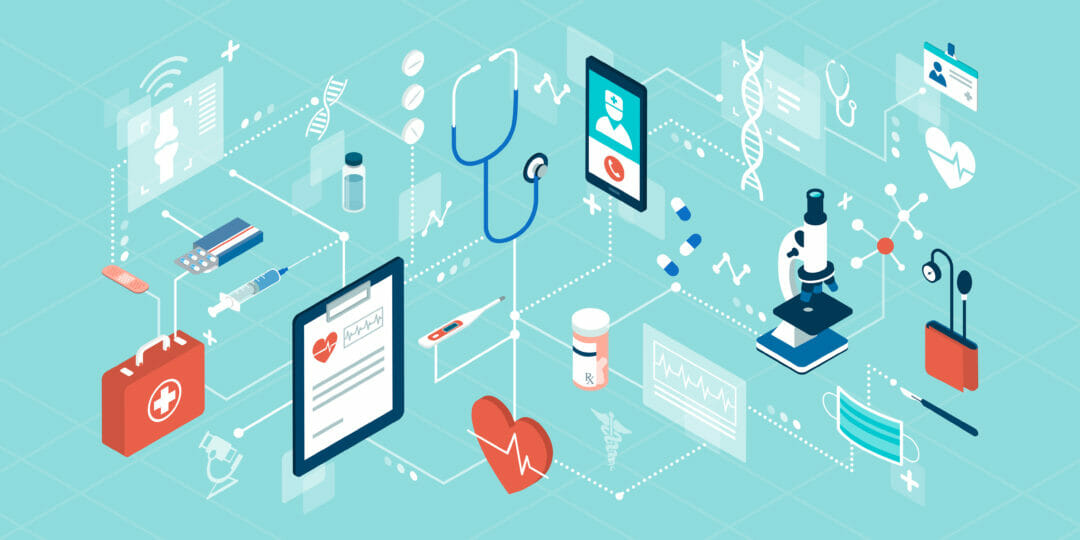The healthcare industry has had an appetite for digitisation and migration of key applications and services to the cloud for years, yet risk mitigation and concerns over ROI has often meant any transformation has been a slow and arduous process.
However, the recent outbreak of the SARS-CoV-2 virus has completely diminished any barriers to change – forcing the healthcare industry to find new and efficient ways of working that heavily rely on cloud and SaaS based solutions. This is to not only ensure widespread, remote access to applications, systems, and data for staff, but to also support new and virtual ways of engaging and assessing patients from the comfort of their homes.
Now, as UK healthcare providers have fought through both waves of the pandemic, industry leaders are looking to change traditional services for the long-term; where initial GP appointments are likely to remain remote via telephone or video call and hospitals and other care facilities continue to build on the digital progress that has already been made over the last 18 months.
The measure of success will not only be improved patient experience and outcomes, but also increased operational efficiencies and the saving of vital costs and resource. Key to achieving this will be maximising the capability of the cloud, whilst integrating new and advancing technologies to enable positive change.
Cloud data and security — what every healthcare technology leader needs to know
Healthcare 24/7
We live and operate in an ‘always on’ 24/7 society, which has filtered through to the healthcare industry. Healthcare practitioners now require ubiquitous access to applications, data, and communications tools; not just because of the realities of COVID and the practicalities of remote working, but also because the focus has shifted to providing 24/7 healthcare through a multitude of media.
In addition to this, the emergence of wearable devices such as fitness bands and heart rate and blood pressure monitors provide patients with access to real time health data, which clinicians can use to build care programs with better outcomes based on smart analysis.
Therefore, this shift in how healthcare providers deliver community support, combined with advances in MedTech have changed how professionals need to consume data – mirroring our ‘always on’ society, whilst emphasising a growing reliance for applications, systems, and patient information to be stored in the cloud; accessible anytime, anyplace and from any secure device.
Saving costs with AI
The NHS is under constant pressure to do more with less and to demonstrate both value and accountability for public money. Continued advances in artificial intelligence, such as robotics, have been trialled and are now used by many trusts to overcome this challenge. For example, the introduction of automation for the huge volume of menial administration tasks, such as staff rostering, not only reduces costs by eliminating expenditure on contract staff, but also improves operational efficiencies.
What’s more, intelligent analysis of patient data through cloud-based platforms can provide healthcare leaders with a consistent and greater understanding of exactly where public funds should be directed, improving patient outcomes whilst enhancing value for money.
AI use cases in healthcare for Covid-19 and beyond
Asset retention with IoT
Healthcare providers, like the NHS, spend masses of their budget on key and vital equipment like defibrillators, monitoring devices, ventilators and even beds. However, by utilising cloud and IoT, providers can be both smarter and more controlled over equipment usage and associated costs. For example, if core devices were tagged with sensors to track location and usage in real-time, providers can analyse their deployment and when, where, and how often they are used across multiple healthcare sites.
Aside from preventing loss of equipment through either theft or misplacement, healthcare providers can also implement an effective Planned Preventative Maintenance strategy to reduce equipment failures whilst saving time, cost, and resource.
Conclusion
Ultimately, the healthcare industry has undergone significant digital transformation over the last 18 months or so, and for many industry professionals this will be a welcome disruption.
However, to continue to build on digital success, healthcare providers need to embrace the true capability of cloud and advancing technologies like IoT and AI, and perceive the recent, COVID-driven digitisation as a foundation for continued and positive change.
In doing so, not only will providers, like the NHS, enter new realms of possibility in healthcare, but they will also continue to transform operations, streamline efficiencies, and improve patient outcomes as a result.








